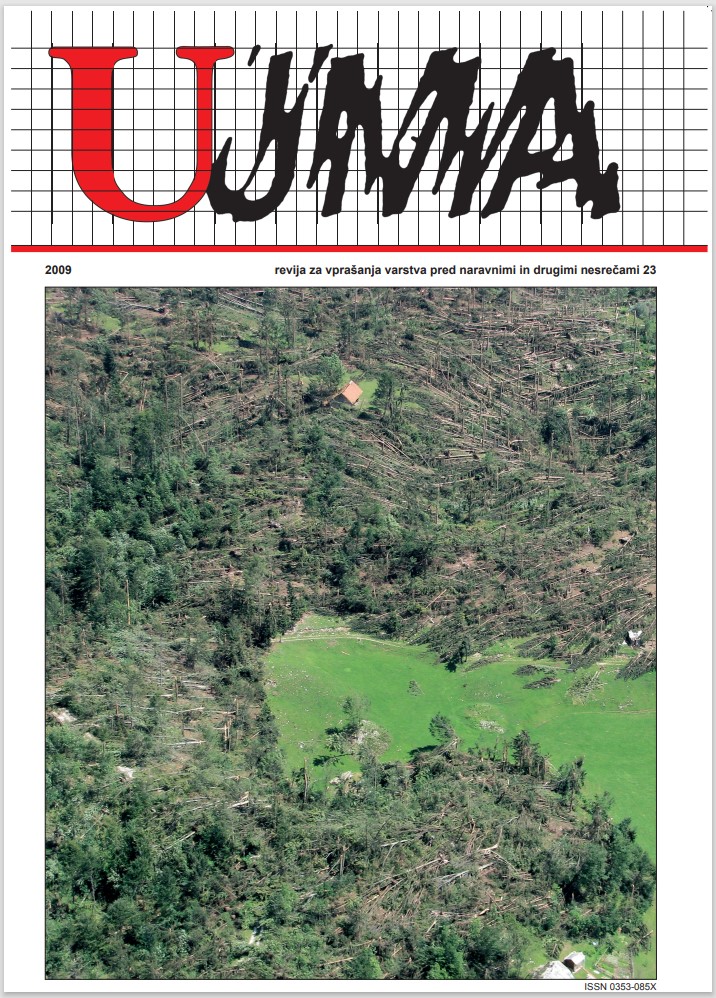THE INFLUENCE OF CLIMATE CHANGE ON EXTREME HYDROLOGICAL EVENTS
Abstract
The effects of global warning and climate change are reflected in more frequent natural catastrophes connected with surfeit or shortage of water. Very high discharges indicate floods, and a long-lasting precipitation deficit indicates low flows and hydrological drought. In 2008, the Intergovernmental Panel on Climate Change (IPCC) issued a Technical Paper on Climate Change and Water, in which it is shown that observational records and climate projections provide abundant evidence that freshwater resources are vulnerable and have the potential to be strongly impacted by climate change, with wide-ranging consequences for human societies and ecosystems. Europe’s sensitivity to climate change increases from north to south. The frequency and occurrence of floods in Slovenia and impacts of climate change on flood discharges, including results of trend analysis, are presented in this article. Not only floods but also hydrological drought is increasing in Slovenia. The results of analysis of low flows and projected climate changes show a decrease of discharge and a longer dry season.
References
CRED, 2008. Disaster statistics. Occurence: trends-century. International Strategy for Disaster Reduction, Centre for Research on the Epidemiology of Disasters. http://www.unisdr.org/disaster-statistics/pdf/isdr-disaster-statistics-occurrence.pdf
Dakova, S., 2004. Low flow and drought spatial analisys. Proceedings of BALWOIS conference, Ohrid, FY Republic of Macedonia, 11pp.
Frantar, P., Kobold, M., Ulaga, F., 2008. Trendi pretokov (v: Vodna bilanca Slovenije 1971-2000, ur. P. Frantar), MOP ARSO, Ljubljana, 50-61.
IPCC, 2008. Climate Change and Water. Technical Paper of the Intergovernmental Panel on Climate Change (Bates, B.C., Kundzewicz, Z.W., Wu, S. and Palutikof, J.P., Eds.) IPCC Secretariat, Geneva, 210 pp.
Kajfež-Bogataj, L., 2006. Podnebne spremembe in nacionalna varnost. Ujma 20, Ljubljana, 170–176.
Kobold, M., 2006. Visoke vode in poplave med 20. in 23. avgustom 2005. Ujma 20, Ljubljana, 48–55.
Kobold, M., 2007 a. Vpliv podnebnih sprememb na pretoke slovenskih rek. Mišičev vodarski dan 2007. Zbornik referatov, VGB, Maribor, 101—108.
Kobold, M., 2007 b. Vpliv napake ocene padavin na napako napovedi odtoka pri napovedovanju poplav. Doktorska disertacija, UL FGG, Ljubljana, 134 str.
Kobold, M., 2008. Katastrofalne poplave in visoke vode 18. septembra 2007. Ujma 22, Ljubljana, 65–75.
Kobold, M., Sušnik, M., 2004. Analiza nizkovodnih razmer slovenskih vodotokov leta 2003. Ujma 17–18, Ljubljana, 120–126.
Kolbezen, M., 1991. Hidrološke značilnosti novembrske visoke vode leta 1990. Ujma 5, Ljubljana, 16–18.
Polajnar, J., 1999. Visoke vode v Sloveniji leta 1998. Ujma 13, Ljubljana, 143-150.
Smith, K. and Ward, R., 1998. Floods. Physical Processes and Human Impacts. John Wiley & Sons, England.
Svensson, C., Kundzewicz, Z.W. and Maurer, T., 2004. Trends in flood and low flow series. GRDC Report 33, Koblenz.
Zupančič, B., 1999. Analiza klimatskih sprememb. Interno poročilo, HMZ RS, Ljubljana.
Downloads
Published
Issue
Section
License

This work is licensed under a Creative Commons Attribution-NonCommercial-NoDerivatives 4.0 International License.
The articles are made available to the public under Creative Commons Attribution-NonCommercial-NoDerivatives 4.0 International (CC BY-NC-ND 4.0).


